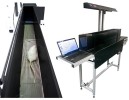Authors
J Mlost, M K_dziora, K Starowicz
Lab
Department of Neurochemistry, Maj Institute of Pharmacology, Polish Academy of Sciences, Cracow, Poland
Journal
Pharmaceuticals
Abstract
Systems pharmacology employs computational and mathematical methods to study the network of interactions a drug may have within complex biological pathways. These tools are well suited for research on multitarget drugs, such as natural compounds, in diseases with complex etiologies, such as osteoarthritis (OA). The present study focuses on cannabidiol (CBD), a non-psychoactive constituent of cannabis, targeting over 60 distinct molecular targets as a potential treatment for OA, a degenerative joint disease leading to chronic pain with a neuropathic component. We successfully identified molecular targets of CBD that were relevant in the context of OA treatment with both beneficial and detrimental effects. Our findings were confirmed by in vivo and molecular studies. A key role of PPARgamma in mediating the therapeutic potential of CBD was revealed, whereas upregulation of multiple transient receptor potential channels demasked CBD-induced heat hyperalgesia. Our findings pave the way for novel CBD-based therapy with improved therapeutic potential but also encourage the use of bioinformatic tools to predict the mechanism of action of CBD in different conditions. We have also created an accessible web tool for analogous analysis of CBD pharmacology in the context of any disease of interest and made it publicly available.
BIOSEB Instruments Used:
Kinetic Weight Bearing (BIO-KWB-DUAL)

 Pain - Thermal Allodynia / Hyperalgesia
Pain - Thermal Allodynia / Hyperalgesia Pain - Spontaneous Pain - Postural Deficit
Pain - Spontaneous Pain - Postural Deficit Pain - Mechanical Allodynia / Hyperalgesia
Pain - Mechanical Allodynia / Hyperalgesia Learning/Memory - Attention - Addiction
Learning/Memory - Attention - Addiction Physiology & Respiratory Research
Physiology & Respiratory Research
 Pain
Pain Central Nervous System (CNS)
Central Nervous System (CNS) Neurodegeneration
Neurodegeneration Sensory system
Sensory system Motor control
Motor control Mood Disorders
Mood Disorders Other disorders
Other disorders Muscular system
Muscular system Joints
Joints Metabolism
Metabolism Cross-disciplinary subjects
Cross-disciplinary subjects Preclinical studies and opioids: role in crisis management in the United States
Preclinical studies and opioids: role in crisis management in the United States 